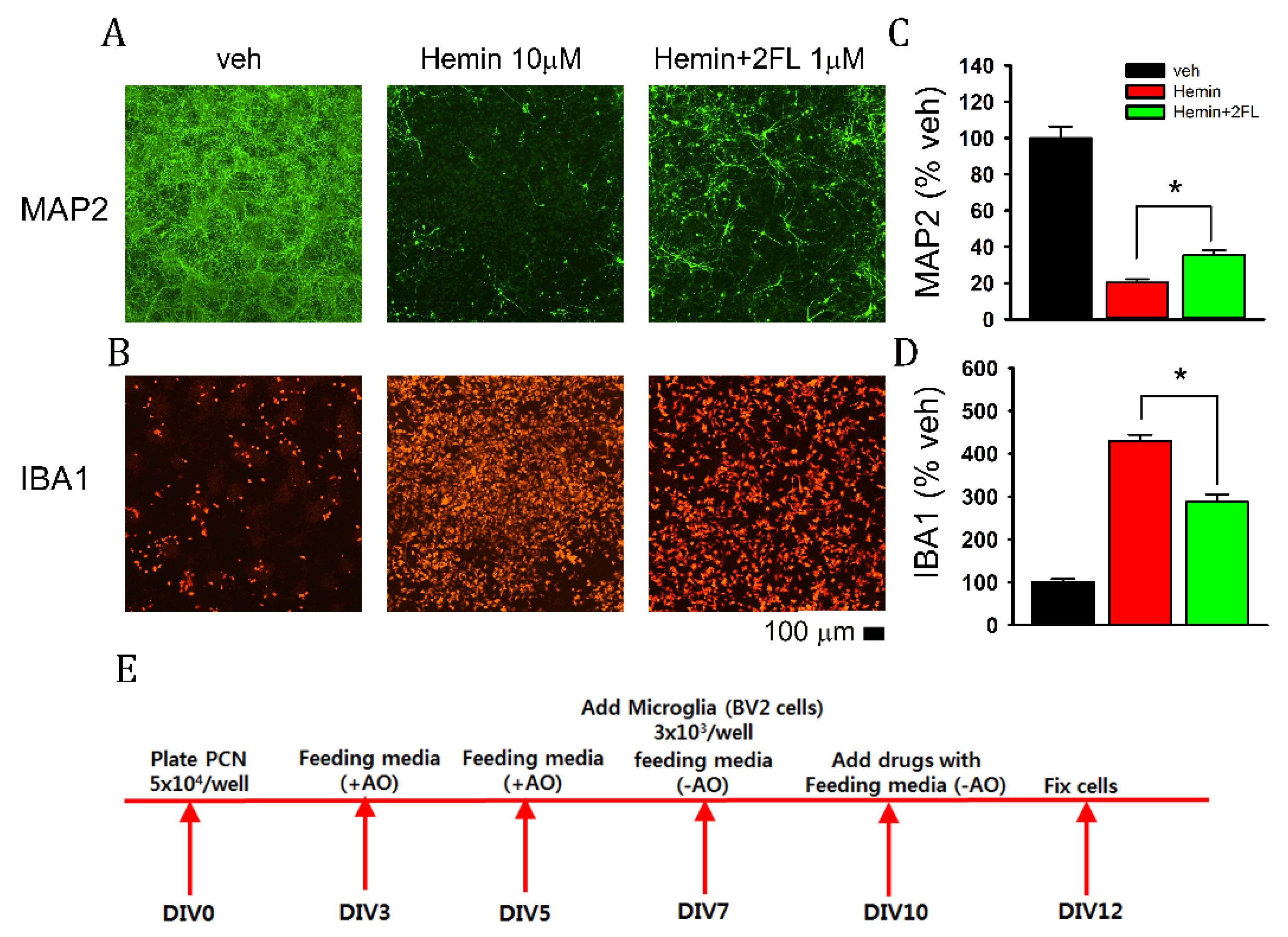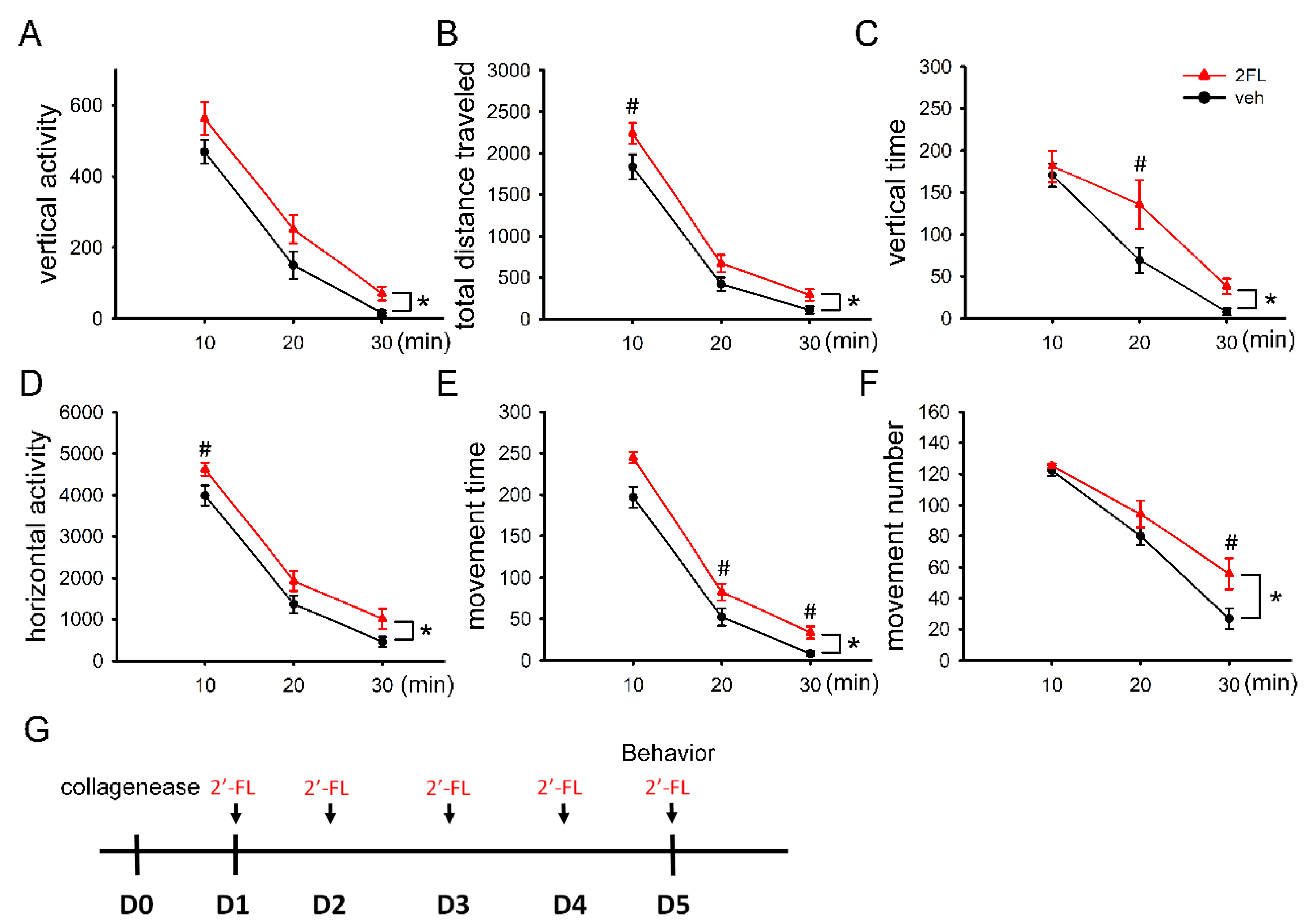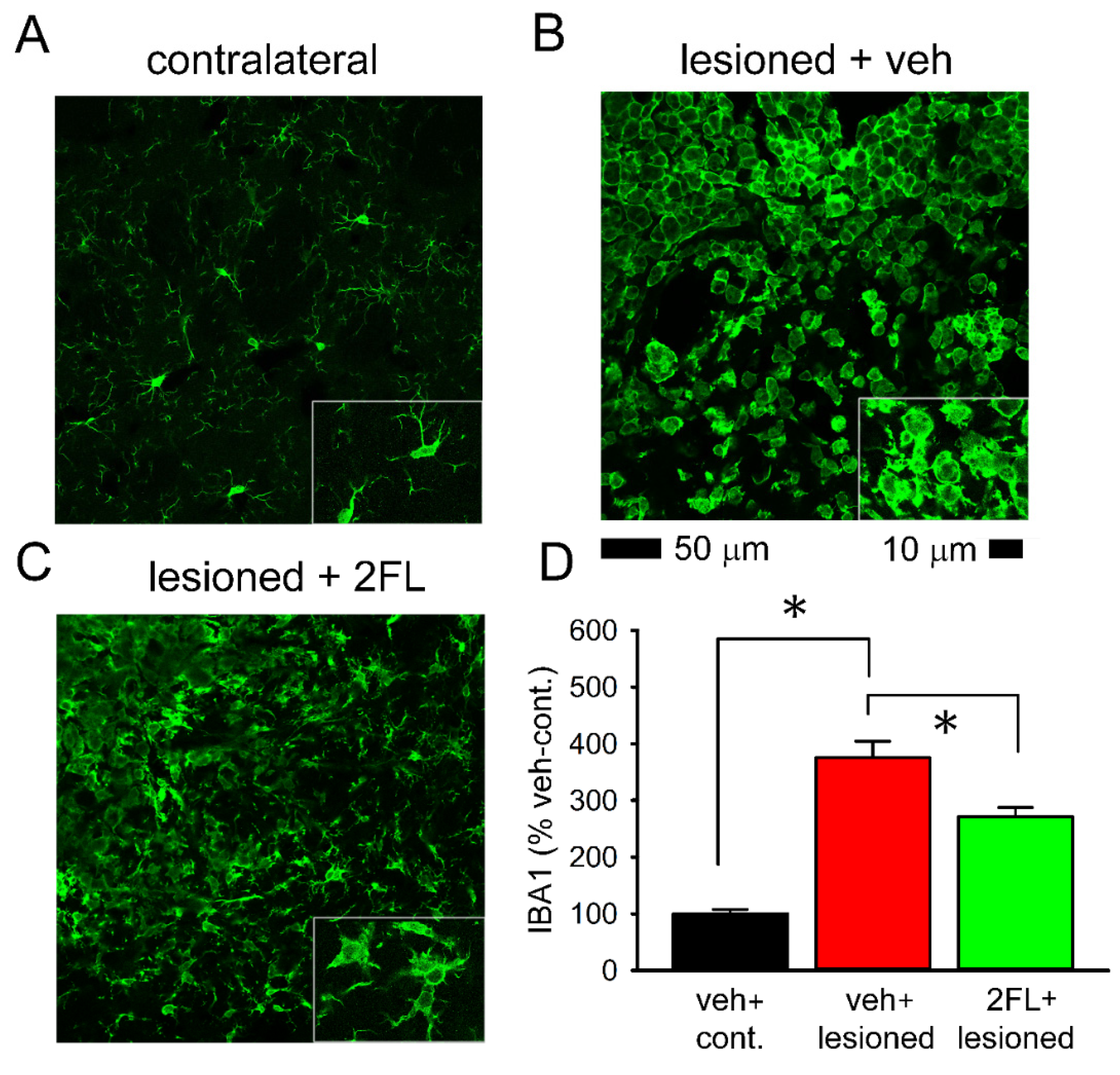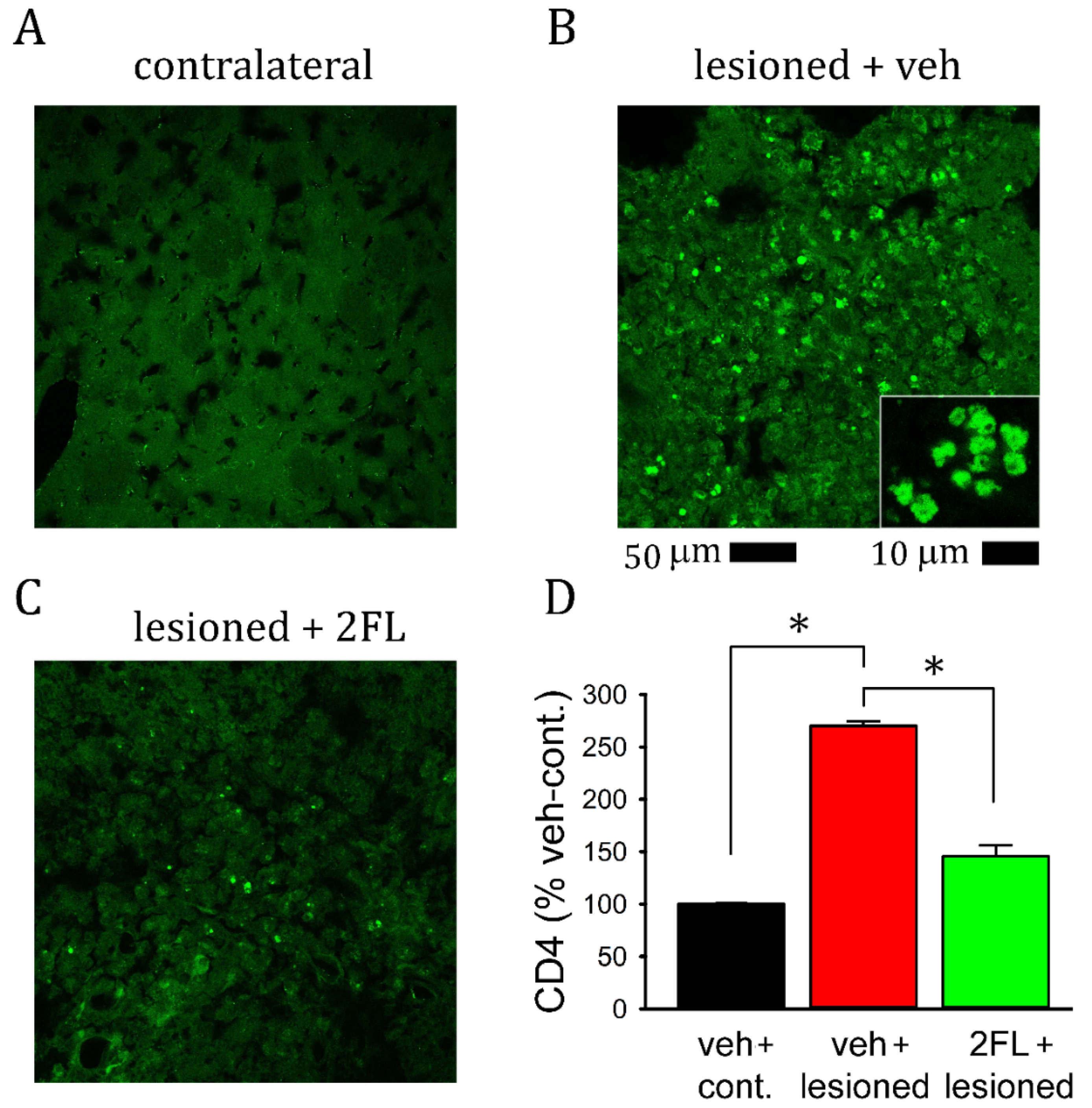Human Milk Oligosaccharide 2′-Fucosyllactose Induces Neuroprotection from Intracerebral Hemorrhage Stroke
Abstract
:1. Introduction
2. Results
2.1. 2FL Reduced Hemin-Mediated Neurodegeneration in Primary Cortical Neurons and BV2 Microglia Coculture
2.2. Post-Treatment with 2FL Improved Locomotor Activity in ICH Rats
2.3. Early Post-Treatment with 2FL Reduced Microglial Activation in the Peri-Lesioned Region
2.4. 2FL Mitigated CD4+ Lymphocyte Infiltration into the Lesioned Brains
2.5. 2FL Differentially Altered the Expression of M1 and M2 Inflammatory Markers in ICH Brains
2.6. 2FL Altered the Expression of ER Stress and Apoptotic Markers in ICH Brains
3. Discussion
4. Materials and Methods
4.1. Animals
4.2. Materials
4.3. Primary Rat Cortical Neuron (PCN) and Microglia Coculture
4.4. Immunocytochemistry
4.5. Surgery
4.6. Locomotor Behavioral Measurement
4.7. Immunohistochemistry
4.8. Quantitative Reverse Transcription PCR (qRTPCR)
4.9. Statistics
Author Contributions
Funding
Institutional Review Board Statement
Informed Consent Statement
Data Availability Statement
Acknowledgments
Conflicts of Interest
References
- Goulart, A.C.; Bensenor, I.M.; Fernandes, T.G.; Alencar, A.P.; Fedeli, L.M.; Lotufo, P.A. Early and one-year stroke case fatality in Sao Paulo, Brazil: Applying the World Health Organization’s stroke STEPS. J. Stroke Cerebrovasc. Dis. 2012, 21, 832–838. [Google Scholar] [CrossRef]
- Kojic, B.; Burina, A.; Hodzic, R.; Pasic, Z.; Sinanovic, O. Risk factors impact on the long-term survival after hemorrhagic stroke. Med. Arch. 2009, 63, 203–206. [Google Scholar]
- Feigin, V.L.; Lawes, C.M.; Bennett, D.A.; Barker-Collo, S.L.; Parag, V. Worldwide stroke incidence and early case fatality reported in 56 population-based studies: A systematic review. Lancet Neurol. 2009, 8, 355–369. [Google Scholar] [CrossRef]
- De Miguel-Yanes, J.M.; Lopez-de-Andres, A.; Jimenez-Garcia, R.; Hernandez-Barrera, V.; de Miguel-Diez, J.; Mendez-Bailon, M.; Perez-Farinos, N.; Munoz-Rivas, N.; Carabantes-Alarcon, D.; Lopez-Herranz, M. Incidence and outcomes of hemorrhagic stroke among adults in Spain (2016–2018) according to sex: A retrospective, cohort, observational, propensity score matched study. J. Clin. Med. 2021, 10, 3753. [Google Scholar] [CrossRef]
- Marrugat, J.; Arboix, A.; Garcia-Eroles, L.; Salas, T.; Vila, J.; Castell, C.; Tresserras, R.; Elosua, R. The estimated incidence and case fatality rate of ischemic and hemorrhagic cerebrovascular disease in 2002 in Catalonia. Rev. Esp. Cardiol. 2007, 60, 573–580. [Google Scholar] [CrossRef] [PubMed]
- Arboix, A.; Garcia-Eroles, L.; Massons, J.; Oliveres, M.; Targa, C. Hemorrhagic lacunar stroke. Cerebrovasc. Dis. 2000, 10, 229–234. [Google Scholar] [CrossRef]
- Keep, R.F.; Hua, Y.; Xi, G. Intracerebral haemorrhage: Mechanisms of injury and therapeutic targets. Lancet Neurol. 2012, 11, 720–731. [Google Scholar] [CrossRef] [Green Version]
- Sheth, K.N.; Rosand, J. Targeting the immune system in intracerebral hemorrhage. JAMA Neurol. 2014, 71, 1083–1084. [Google Scholar] [CrossRef] [PubMed]
- Chu, X.; Wu, X.; Feng, H.; Zhao, H.; Tan, Y.; Wang, L.; Ran, H.; Yi, L.; Peng, Y.; Tong, H.; et al. Coupling between interleukin-1R1 and necrosome complex involves in hemin-induced neuronal necroptosis after intracranial hemorrhage. Stroke 2018, 49, 2473–2482. [Google Scholar] [CrossRef]
- Gram, M.; Sveinsdottir, S.; Ruscher, K.; Hansson, S.R.; Cinthio, M.; Akerstrom, B.; Ley, D. Hemoglobin induces inflammation after preterm intraventricular hemorrhage by methemoglobin formation. J. Neuroinflamm. 2013, 10, 100. [Google Scholar] [CrossRef] [Green Version]
- Tschoe, C.; Bushnell, C.D.; Duncan, P.W.; Alexander-Miller, M.A.; Wolfe, S.Q. Neuroinflammation after intracerebral hemorrhage and potential therapeutic targets. J. Stroke 2020, 22, 29–46. [Google Scholar] [CrossRef] [Green Version]
- Wang, J. Preclinical and clinical research on inflammation after intracerebral hemorrhage. Prog. Neurobiol. 2010, 92, 463–477. [Google Scholar] [CrossRef] [Green Version]
- Yu, S.-J.; Wu, K.-J.; Wang, Y.-S.; Song, J.-S.; Wu, C.-H.; Jan, J.-J.; Bae, E.; Chen, H.; Shia, K.-S.; Wang, Y. Protective effect of CXCR4 antagonist CX807 in a rat model of hemorrhagic stroke. Int. J. Mol. Sci. 2020, 21, 7085. [Google Scholar] [CrossRef]
- Mosca, F.; Gianni, M.L. Human milk: Composition and health benefits. Pediatr. Med. Chir. 2017, 39, 155. [Google Scholar] [CrossRef] [Green Version]
- Donovan, S.M.; Comstock, S.S. Human milk oligosaccharides influence neonatal mucosal and systemic immunity. Ann. Nutr. Metab. 2016, 69, S42–S51. [Google Scholar] [CrossRef]
- Oliveros, E.; Ramirez, M.; Vazquez, E.; Barranco, A.; Gruart, A.; Delgado-Garcia, J.M.; Buck, R.; Rueda, R.; Martin, M.J. Oral supplementation of 2′-fucosyllactose during lactation improves memory and learning in rats. J. Nutr. Biochem. 2016, 31, 20–27. [Google Scholar] [CrossRef]
- Vazquez, E.; Barranco, A.; Ramirez, M.; Gruart, A.; Delgado-Garcia, J.M.; Martinez-Lara, E.; Blanco, S.; Martin, M.J.; Castanys, E.; Buck, R.; et al. Effects of a human milk oligosaccharide, 2′-fucosyllactose, on hippocampal long-term potentiation and learning capabilities in rodents. J. Nutr. Biochem. 2015, 26, 455–465. [Google Scholar] [CrossRef] [PubMed]
- He, Y.; Liu, S.; Kling, D.E.; Leone, S.; Lawlor, N.T.; Huang, Y.; Feinberg, S.B.; Hill, D.R.; Newburg, D.S. The human milk oligosaccharide 2′-fucosyllactose modulates CD14 expression in human enterocytes, thereby attenuating LPS-induced inflammation. Gut 2016, 65, 33–46. [Google Scholar] [CrossRef] [PubMed] [Green Version]
- Wu, K.-J.; Chen, Y.-H.; Bae, E.-K.; Song, Y.; Min, W.; Yu, S.-J. Human milk oligosaccharide 2′-fucosyllactose reduces neurodegeneration in stroke brain. Transl. Stroke Res. 2020, 11, 1001–1011. [Google Scholar] [CrossRef] [PubMed]
- Wang, T.; Lu, H.; Li, D.; Huang, W. TGF-beta1-mediated activation of SERPINE1 is involved in hemin-induced apoptotic and inflammatory injury in HT22 cells. Neuropsychiatr. Dis. Treat. 2021, 17, 423–433. [Google Scholar] [CrossRef]
- Dang, T.N.; Bishop, G.M.; Dringen, R.; Robinson, S.R. The metabolism and toxicity of hemin in astrocytes. Glia 2011, 59, 1540–1550. [Google Scholar] [CrossRef]
- Robinson, S.R.; Dang, T.N.; Dringen, R.; Bishop, G.M. Hemin toxicity: A preventable source of brain damage following hemorrhagic stroke. Redox Rep. 2009, 14, 228–235. [Google Scholar] [CrossRef]
- Gutteridge, J.M.; Smith, A. Antioxidant protection by haemopexin of haem-stimulated lipid peroxidation. Biochem. J. 1988, 256, 861–865. [Google Scholar] [CrossRef] [Green Version]
- Dai, J.; Wu, P.; Xu, S.; Li, Y.; Zhu, Y.; Wang, L.; Wang, C.; Zhou, P.; Shi, H. Changes in mitochondrial ultrastructure in SH-SY5Y cells during apoptosis induced by hemin. Neuroreport 2017, 28, 551–554. [Google Scholar] [CrossRef]
- Lin, S.; Yin, Q.; Zhong, Q.; Lv, F.-L.; Zhou, Y.; Li, J.-Q.; Wang, J.-Z.; Su, B.-Y.; Yang, Q.-W. Heme activates TLR4-mediated inflammatory injury via MyD88/TRIF signaling pathway in intracerebral hemorrhage. J. Neuroinflamm. 2012, 9, 46. [Google Scholar] [CrossRef] [Green Version]
- Wang, Y.-C.; Zhou, Y.; Fang, H.; Lin, S.; Wang, P.-F.; Xiong, R.-P.; Chen, J.; Xiong, X.-Y.; Lv, F.-L.; Liang, Q.-L.; et al. Toll-like receptor 2/4 heterodimer mediates inflammatory injury in intracerebral hemorrhage. Ann. Neurol. 2014, 75, 876–889. [Google Scholar] [CrossRef] [PubMed]
- Kuramatsu, J.B.; Huttner, H.B.; Schwab, S. Advances in the management of intracerebral hemorrhage. J. Neural. Transm. 2013, 120, S35–S41. [Google Scholar] [CrossRef]
- Suzuki, S.; Kelley, R.E.; Dandapani, B.K.; Reyes-Iglesias, Y.; Dietrich, W.D.; Duncan, R.C. Acute leukocyte and temperature response in hypertensive intracerebral hemorrhage. Stroke 1995, 26, 1020–1023. [Google Scholar] [CrossRef] [PubMed]
- Wang, J.; Dore, S. Inflammation after intracerebral hemorrhage. J. Cereb. Blood Flow Metab. 2007, 27, 894–908. [Google Scholar] [CrossRef] [Green Version]
- Stevens, S.L.; Bao, J.; Hollis, J.; Lessov, N.S.; Clark, W.M.; Stenzel-Poore, M.P. The use of flow cytometry to evaluate temporal changes in inflammatory cells following focal cerebral ischemia in mice. Brain Res. 2002, 932, 110–119. [Google Scholar] [CrossRef]
- Yu, Z.T.; Nanthakumar, N.N.; Newburg, D.S. The human milk oligosaccharide 2′-fucosyllactose quenches campylobacter jejuni-induced inflammation in human epithelial cells HEp-2 and HT-29 and in mouse intestinal mucosa. J. Nutr. 2016, 146, 1980–1990. [Google Scholar] [CrossRef] [PubMed]
- Good, M.; Sodhi, C.P.; Yamaguchi, Y.; Jia, H.; Lu, P.; Fulton, W.B.; Martin, L.Y.; Prindle, T.; Nino, D.F.; Zhou, Q.; et al. The human milk oligosaccharide 2′-fucosyllactose attenuates the severity of experimental necrotising enterocolitis by enhancing mesenteric perfusion in the neonatal intestine. Br. J. Nutr. 2016, 116, 1175–1187. [Google Scholar] [CrossRef] [PubMed] [Green Version]
- Thangameeran, S.I.M.; Tsai, S.-T.; Hung, H.-Y.; Hu, W.-F.; Pang, C.-Y.; Chen, S.-Y.; Liew, H.-K. A role for endoplasmic reticulum stress in intracerebral hemorrhage. Cells 2020, 9, 750. [Google Scholar] [CrossRef] [PubMed] [Green Version]
- Huang, Q.; Lan, T.; Lu, J.; Zhang, H.; Zhang, D.; Lou, T.; Xu, P.; Ren, J.; Zhao, D.; Sun, L.; et al. DiDang tang inhibits endoplasmic reticulum stress-mediated apoptosis induced by oxygen glucose deprivation and intracerebral hemorrhage through blockade of the GRP78-IRE1/PERK pathways. Front. Pharmacol. 2018, 9, 1423. [Google Scholar] [CrossRef] [Green Version]
- Zhang, Z.; Cho, S.; Rehni, A.K.; Quero, H.N.; Dave, K.R.; Zhao, W. Automated assessment of hematoma volume of rodents subjected to experimental intracerebral hemorrhagic stroke by bayes segmentation approach. Transl. Stroke Res. 2020, 11, 789–798. [Google Scholar] [CrossRef]
- Bode, L. Human milk oligosaccharides: Prebiotics and beyond. Nutr. Rev. 2009, 67, S183–S191. [Google Scholar] [CrossRef]
- Yu, S.-J.; Wu, K.-J.; Bae, E.; Wang, Y.-S.; Chiang, C.-W.; Kuo, L.-W.; Harvey, B.K.; Greig, N.H.; Wang, Y. Post-treatment with posiphen reduces endoplasmic reticulum stress and neurodegeneration in stroke brain. iScience 2020, 23, 100866. [Google Scholar] [CrossRef] [Green Version]






| ICH Veh vs. ICH 2FL | |||
|---|---|---|---|
| F Value | Number of Animal | p Value | |
| VACTV | 5.527 | 14 | 0.024 |
| TOTDIST | 11.173 | 14 | 0.002 |
| VTIME | 6.676 | 14 | 0.014 |
| HACTV | 11.534 | 14 | 0.002 |
| MOVTIME | 22.421 | 14 | <0.001 |
| MOVNO | 8.003 | 14 | 0.008 |
| Gene | SYBR Green | TagMan | |
|---|---|---|---|
| Forward | Reverse | ||
| CD86 | TAGGGATAACCAGGCTCTAC | CGTGGGTGTCTTTTGCTGTA | |
| CD206 | AGTTGGGTTCTCCTGTAGCCCAA | ACTACTACCTGAGCCCACACCTGCT | |
| TGFβ | GCTGAACCAAGGAGACGGAAT | CGGTTCATGTCATGGATGGTG | |
| PERK | GAAGTGGCAAGAGGAGATGG | GAGTGGCCAGTCTGTGCTTT | |
| IRE1 | TCATCTGGCCTCTTCTCTCGGA | TTGAGTGAGTGGTTGGAGGC | |
| CHOP | ACCACCACACCTGAAAGCAG | AGCTGGACACTGTCTCAAAG | |
| Sigmar1 | AAAGTGAGGTCTATTACCCAGGAG | TTTGGTCCCCACTCCACA | |
| Bip | TCGACTTGGGGACCACCTAT | GCCCTGATCGTTGGCTATGA | |
| ATF6 | GGACCAGGTGGTGTCAGAG | GACAGCTCTGCGCTTTGGG | |
| Caspase3 | GTGGAACTGACGATGATATGGC | CGCAAAGTGACTGGATGAACC | |
| β-Actin | Rn00667869_m1 | ||
| GAPDH | Rn01775763_g1 | ||
Publisher’s Note: MDPI stays neutral with regard to jurisdictional claims in published maps and institutional affiliations. |
© 2021 by the authors. Licensee MDPI, Basel, Switzerland. This article is an open access article distributed under the terms and conditions of the Creative Commons Attribution (CC BY) license (https://creativecommons.org/licenses/by/4.0/).
Share and Cite
Hung, T.-W.; Wu, K.-J.; Wang, Y.-S.; Bae, E.-K.; Song, Y.; Yoon, J.; Yu, S.-J. Human Milk Oligosaccharide 2′-Fucosyllactose Induces Neuroprotection from Intracerebral Hemorrhage Stroke. Int. J. Mol. Sci. 2021, 22, 9881. https://doi.org/10.3390/ijms22189881
Hung T-W, Wu K-J, Wang Y-S, Bae E-K, Song Y, Yoon J, Yu S-J. Human Milk Oligosaccharide 2′-Fucosyllactose Induces Neuroprotection from Intracerebral Hemorrhage Stroke. International Journal of Molecular Sciences. 2021; 22(18):9881. https://doi.org/10.3390/ijms22189881
Chicago/Turabian StyleHung, Tsai-Wei, Kuo-Jen Wu, Yu-Syuan Wang, Eun-Kyung Bae, YoungHa Song, JongWon Yoon, and Seong-Jin Yu. 2021. "Human Milk Oligosaccharide 2′-Fucosyllactose Induces Neuroprotection from Intracerebral Hemorrhage Stroke" International Journal of Molecular Sciences 22, no. 18: 9881. https://doi.org/10.3390/ijms22189881
APA StyleHung, T.-W., Wu, K.-J., Wang, Y.-S., Bae, E.-K., Song, Y., Yoon, J., & Yu, S.-J. (2021). Human Milk Oligosaccharide 2′-Fucosyllactose Induces Neuroprotection from Intracerebral Hemorrhage Stroke. International Journal of Molecular Sciences, 22(18), 9881. https://doi.org/10.3390/ijms22189881






